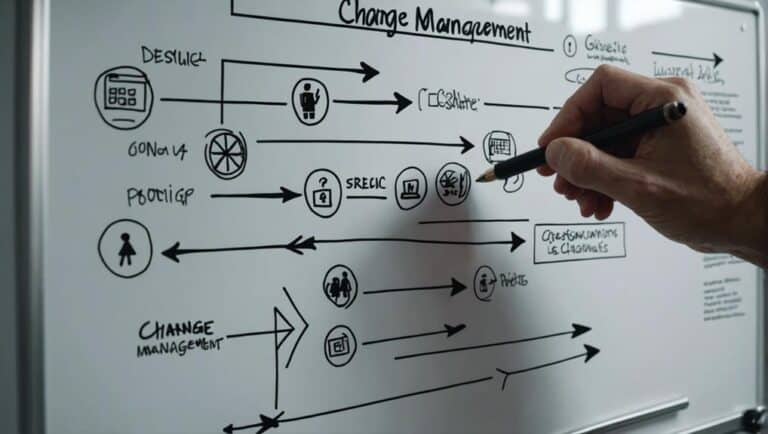Did you know that only around 30% of change management initiatives succeed when ownership is transferred?
It's crucial to grasp the importance of ownership handovers in change management for the sustained success of any organization.
By understanding the ins and outs of this process and taking proactive steps to navigate it, you can ensure a smooth transition that paves the way for future growth and success.
Key Takeaways
Make sure everyone knows what they're supposed to do to avoid confusion and arguments. Give people the training they need for their specific job so they can do it well. Talk openly with each other to build trust and make it easy to pass on tasks smoothly. Encourage everyone to take responsibility and care about their work to create a really good working environment. Make sure that when someone new takes over, it fits with where we want to go in the future for long-term success.
Defining Roles and Responsibilities
When you're figuring out who does what during the ownership change, make sure everyone knows their job and what they're in charge of in the company. It's really important to define these roles so that the handover goes smoothly.
By laying out who does what, you make sure everyone knows what they're responsible for, which helps prevent conflicts and makes things run more efficiently. It also helps to spot any gaps in knowledge or coverage early on, so you can fix them before they become a problem.
When you're giving out tasks, think about what each person is good at and what they know, so you can make sure everyone is working at their best and handling all parts of the change well. If everyone knows their job, they can all work together towards making the ownership handover a success.
Just remember, making roles and responsibilities clear is super important for the whole change process to go well.
Providing Relevant Training and Resources
If you want to make training programs more effective, you should customize them to meet the needs of employees who are part of the ownership shift. Providing easier access to resources like online courses, workshops, and mentoring can help employees better understand the transformation process.
It's important to make sure that the training covers key areas such as financial management, leadership skills, and legal aspects to help employees get ready for the change.
Training Program Development
When you're transitioning ownership, it's crucial to create a training program that fits the different job roles and levels in your company. This program should cover the new processes, systems, roles, and duties that will be in place after the change.
By tailoring the training to each specific job function and level, you ensure that employees have the tools they need to keep learning and growing. Providing manuals, guides, and online courses can help support their development.
It's important to regularly get feedback and assess how effective the training is so you can make adjustments and get the best results. Remember, good training is key to a smooth ownership handover.
Resource Accessibility Optimization
To make ownership change management smoother, it's important to offer customized training programs and relevant resources that are easy to access. These programs help employees understand their new roles after the handover.
Tailored resources for different stakeholders make it easier for everyone to adjust to the new ownership structure. Online modules and workshops provide better learning opportunities for all involved.
By promoting continuous learning, you can ensure a successful handover process. Giving stakeholders the tools and knowledge they need through accessible resources helps them feel prepared and confident during the transition.
Emphasizing easy access to resources in training and materials is key to managing the complexities of ownership handover effectively.
Encouraging Open Communication
When ownership changes happen, it's important to have open and honest conversations within your organization. Make sure everyone feels comfortable sharing their thoughts and listen actively to address any worries and make sure everyone is on the same page.
Trust is key in these situations, so keeping communication transparent helps make the transition as smooth as possible.
Foster Transparent Dialogue
Encourage open and honest communication by making sure current and incoming owners can talk openly during the ownership handover. It's important to have clear channels for discussion to address expectations, concerns, and plans. This helps build trust, ensures everyone is on the same page, and allows for a smooth transfer.
By having transparent conversations, any potential conflicts can be dealt with early on, roles can be defined, and everyone can work together effectively. Creating a culture of open dialogue makes both current and incoming owners feel respected and involved in the handover process.
Emphasizing the importance of communication will help simplify the ownership handover process and set the stage for a successful transfer.
Promote Active Listening
Switching from having open and honest conversations to making sure you listen actively when handing over ownership is crucial for smooth communication and trust-building among stakeholders. Active listening means really focusing on, understanding, and responding to what's being said in a conversation.
By promoting active listening, you demonstrate respect, empathy, and genuine interest in others' viewpoints, which encourages open communication. This approach helps to minimize misunderstandings, conflicts, and pushback during the change management process.
Additionally, fostering active listening can cultivate a culture of transparency and collaboration that's essential for a successful transfer of ownership.
Build Trust Through Communication
Building trust during ownership handovers in an organization starts with open communication. When we're open and honest, it paves the way for trust to grow. By welcoming feedback and having conversations, we create a collaborative atmosphere that involves everyone in the handover process. Keeping everyone informed through clear and regular communication helps them feel included and builds trust and unity.
Good communication helps prevent misunderstandings, lowers resistance, and makes the transition smoother. When we've open lines of communication, it not only boosts morale but also increases confidence and makes the organization more resilient. Embracing these practices is essential for promoting trust, strengthening relationships, and ensuring a successful ownership handover.
Fostering a Culture of Accountability
Creating a culture of accountability in a company means making sure everyone takes ownership of their work and decisions. When people feel accountable, they're more likely to be reliable and trustworthy, which helps teams work better together and get more done. It's important to be clear about what's expected and what happens if goals aren't met, so everyone understands the consequences. Transparency is key in accountability because it helps solve problems faster and leads to overall success for the organization.
When individuals feel responsible for their actions, they're motivated to work towards common goals and move the organization forward. Encouraging ownership and responsibility not only gives people a sense of purpose and duty but also strengthens collaboration and trust within the team. Building a culture of accountability sets the stage for a united and high-performing work environment.
Structured Support and Guidance
When you're passing on ownership, it's super important to have some solid help and guidance to handle all the important stuff and make sure everything goes smoothly. If your business is going through a change in ownership, it's a good idea to bring in a team that specializes in managing change to give you the support you need. This team can help you figure out the tricky parts of organizational changes, make sure you're following all the legal rules, keep your stakeholders in the loop, and use effective change management strategies.
Getting structured support during an ownership shift means you need to plan things out carefully. You'll have to deal with things like figuring out the value of your business, understanding the tax implications, and making sure all the legal paperwork is in order. It's really important to keep your business running smoothly during this transition so you don't disrupt your customer relationships or how things operate. Whether you're selling to someone else or transferring ownership to your employees, you'll need personalized guidance to make sure the switch is seamless.
Aligning With Strategic Vision and Goals
When you're passing on ownership of a business, it's crucial to weave in the company's strategic vision and goals. This ensures that the transition sets the stage for long-term success. Matching the ownership handover with the organization's strategic direction is key. It helps make the shift smooth and supports the company's future plans and competitive edge.
By linking the ownership transfer to the company's mission, values, and overall business objectives, you maintain alignment with the strategic vision. This not only eases the transition but also boosts the company's ability to compete effectively. Prioritizing this alignment guarantees that the ownership change not only succeeds but also propels the company towards its long-term goals.
Embracing strategic alignment throughout the ownership transfer is vital for securing the company's future success and market position. It's all about making sure that the handover contributes positively to the company's growth and sustainability.
Frequently Asked Questions
What Are the 7 Steps of Change Management?
To make sure changes in an organization go smoothly, you should know the 7 steps of change management. First, you need to figure out what changes are needed. Then, you have to plan how to make those changes happen. It's important to get the right people on board, so forming teams is a key step.
Once you have your teams in place, being open and honest in your communication is crucial. You want everyone to be on the same page. Next, you'll start making changes little by little, checking in along the way. After the changes have been made, it's time to see if they had the desired effect.
Lastly, to make sure the changes stick, you need to embed them into how things are done. These steps are the roadmap to successful transformations and lasting change in organizations.
What Are the 5 C's of Change Management?
To successfully manage change, remember the 5 C's: Communication, Collaboration, Commitment, Culture, and Competence. Make sure to keep everyone in the loop, work together, stay dedicated, align cultures, and improve skills. By using these strategies and leading effectively, you can navigate change smoothly.
What Are the 5 R's of Change Management?
If you want to do well in change management, you gotta remember the 5 R's: Reasons, Return, Risks, Resources, Responsibility. Basically, know why you're doing it, what you'll get out of it, what could go wrong, what you need to make it happen, and who's in charge. Get the point, think ahead, tackle problems, gather tools, and take charge to make those changes stick.
What Are the 7 R's in Change Management?
When you use the 7 R's in change management, it helps you deal with resistance, involve stakeholders well, encourage teamwork, get leaders on the same page, shape the culture, provide training, and assess how things are going. Get good at these steps to succeed.
Conclusion
In short, following a step-by-step guide for managing change during a shift in ownership is key to a successful handover. Make sure everyone knows their roles and responsibilities, give them the training and tools they need, keep communication lines open, create a culture of accountability, provide support and guidance, and stay aligned with the company's goals.
By doing all of this, organizations can ensure a smooth transition. For example, a company that had a solid succession plan in place saw a smooth change in leadership and continued success in the market.





